“The coots are back!” is a sentence that I never imagined myself exclaiming with such joy, but here we are. It’s mid-October and the American coots are definitely back, congregating in large flocks on our nearby lakes. I missed them more than I expected.
Fall migration has come in waves, with shorebirds in August, warblers in September, and sparrows in October. Late October and November kicks off waterfowl season, bringing us swans, geese, ducks, coots, loons, and grebes galore. Many of these birds will stick around until there’s no open water, meaning the next few months will be prime time for waterfowl watching.
This week’s Entryway to Birding blog will help you get familiar with the wide variety of waterbirds you might see over the next few months—and help you cultivate an appreciation for everything from their gorgeous plumages to their weird antics.
Learning to sort out different types of birds you’re likely to see on the water is the first step in getting better at waterfowl identification. This week’s post will focus on the types of birds you’ll see and some locations you might go look for them. Next week, I’ll have a follow-up post with more in-depth advice about the particulars of waterfowl identification.
This is just a small portion of a large American coot flock on University Bay in Madison this week. These black chicken-like birds often get mistaken for ducks—but they aren’t ducks at all! Coots are in an entirely different family, along with rails and gallinules. Look for their white bills and listen for their squawking. You might think they look a little funny at first, but they’ll grow on you. I guarantee it. My nickname for them quickly became “American cutes!” Photo by Caitlyn Schuchhardt
More Than “Just Ducks”
I’ll be honest, when I was a brand new birder I didn’t think much of waterfowl. I had this assumption that they were boring. Like, why would anyone put in so much effort to look at mallards and geese? I thought. The truth is I didn’t really know how to appreciate waterfowl. I didn’t realize what diversity and character and beauty I could see.
But then I saw a bufflehead. And then I saw a canvasback. And then I saw a common goldeneye throw its head back during a mating display! And I realized that ducks run the gamut from “adorable” to “stunningly gorgeous” to “goofy as hell.” They won me over—mallards included!
Photos: bufflehead by Becky Matsubura / canvasback by Dan Streiffert / common goldeneye by Thomas Landgren
And guess what? Ducks are only just the beginning! “Waterfowl”' generally refers to ducks and geese, but often grouped into this category are other waterbirds that migrate this time of year as well—like those American coots, grebes, loons, and trumpeter and tundra swans.
If you’re just getting acquainted with waterfowl, your first step should be to familiarize yourself with the wide variety of species you might find on the water. If you encounter a large, mixed raft of birds huddled in a bay on a nearby lake, you’ll be more easily able to sort through what’s a diving duck, a dabbling duck, or not a duck at all. And—if you’re anything like I was—you’ll be shocked at how many species there are to see, each gorgeous and unique in its own way.
The Who’s Who of Waterfowl
Geese
Photos by Monica Hall
I know y’all have seen Canada geese before. They may not seem “exciting” but I guarantee you’ll have a new appreciation for them when you see them gathered by the thousands. Watching flocks of thousands of geese land or take off from the water is a visual and auditory thrill.
You’d be smart to not assume that every goose in that flock is a Canada goose this time of year, too. Keep your eyes peeled for flocks of greater white-fronted geese, nicknamed “specklebellies” for the black barring on their bellies. Their presence is on the rise in Wisconsin over the last several decades. They have a unique, squeaky call (listen here), so if you hear a flock of geese flying above that isn’t “honking” quite like you’d expect Canada geese to, you should take a second look.
Mixed in with flocks of Canada geese may be some snow geese, of which there are white- and blue-morphs. These are more common in rural areas as these geese like to feed in cornfields. If you’re birding somewhere in town, don’t be fooled by domestic geese often found at local parks, which can also be white in color.
Swans
Photos by Arlene Koziol
Our region of south-central Wisconsin will see both tundra and trumpeter swans. These species can be incredibly difficult to differentiate as they look very similar. Trumpeter swans are larger than tundra swans, with a more even, straight slope from their bill to forehead and an all-black bill. We’ll usually only see them in small numbers. Hearing their bugling, trumpet-like call is one of the best ways to get a definitive ID.
Tundra swans we’ll likely see in much greater numbers. When you see large flocks of swans gathered on the water or sleeping on the ice later in winter, these large flocks are almost certainly tundra swans. They are slightly smaller than trumpeters, with a very slight concave curve to their bill slope. They will often (but not always!) have a patch of yellow at their lores, where their bill meets the eye. Their calls sound more like hoots or barks, and when they are gathered in large flocks you'll notice a hoo-hoo-hoo murmuring sound.
Ducks — Dabblers, Divers, Mergansers, and Scoters
There are so many species of duck you might see that it can and probably will feel overwhelming. That’s okay! I’ll have another post coming soon that will explore the diversity of ducks you’ll find this season with tips on identifying them, but for now I recommend flipping through your field guide and looking at the different categories of duck (yes, there are so many they fall into categories!) and learn how to spot the differences among them.
Photos: blue-winged teal by Doug Greenberg / redhead by Robert Pruner / common mergansers by Eric Ellingson / surf scoter by Mick Thompson
For instance, we’ve got …
Dabbling ducks. When these ducks feed, they’ll tip forward in the water so their rear-ends are pointed up in the air or they’ll skim food from the surface of the water using their bills. You’ve seen this behavior with the classic mallards, for sure, but also included in this category are wood ducks, blue-winged teal, green-winged teal, American wigeon, northern pintail, northern shoveler, and gadwall.
Diving ducks. Other ducks will look for food much deeper under the water and will fully dive below the surface as they forage (though they may dabble in shallow water). I am always impressed at how long many will stay below the surface—and how far away they might pop back up! These ducks include canvasbacks, redheads, ring-necked ducks, ruddy ducks, greater and lesser scaup, common goldeneye, and buffleheads.
Mergansers. Mergansers are a type of fish-eating diving duck (technically part of the “diving” group above) but they visually look pretty different than other ducks—and it’s all in the shape of their bill! They’ve got thinner, longer bills with serrated edges that help them grip slippery fish. They’ve also got a longer, sleeker look to them than other ducks. During migration, we’ll see common mergansers, red-breasted mergansers, and hooded mergansers.
Scoters. There are three types of scoters—white-winged, black, and surf scoter—which are all very stocky sea ducks with hefty bills, also considered part of the “diving” ducks group. These birds are a rare treat! We’ll get a few each season (in their non-breeding plumage), but not in great numbers like other ducks.
Three black scoters line up on Lake Monona. Birders were having a heyday when all three scoter species—black scoter, white-winged scoter, and surf scoter—were all found among the same coot flock on Lake Monona! Here’s my digiscoped photo of the three black scoters that were present. Photo by Caitlyn Schuchhardt
Coots, Grebes, and Loons — AKA the “Not Ducks”
An American coot showing off its impressive feet. Photo by Brandyn Kerscher
Mixed into large rafts of waterfowl on the water, you’ll find some “duck-like” birds that aren’t actually ducks at all. Coots, grebes, and loons each belong to different families.
American coots lack the webbed feet of ducks in favor of some really crazy-looking lobed toes that make them adept on water and on land … and in coot wrestling matches. (Yes, seriously. Look at those toes! Amazing!) They often gather in huge flocks—be sure to scan them carefully since other ducks are likely mixed in or nearby!
A pied-billed grebe is pictured here. Grebes tend to be solitary and not found in flocks, but you’ll often find them near other rafts of waterfowl. Photo by Allen Hack
Grebes also lack webbed feet in favor of lobed toes, but their legs attach further back on their body than those of coots or ducks, making it very awkward for them to move on land. You’ll most commonly see pied-billed grebes (with shorter, chunky bills ringed in black) but our region may see small numbers of horned grebes, eared grebes, and red-necked grebes in their winter plumages.
A common loon on Lake Wingra. Look at that dagger of a bill! Their sharp, sleek profile makes them easy to identify from a distance. Photo by Brandyn Kerscher
Loons, unlike coots and grebes, do have webbed feet. But their legs are like grebes in that they’re placed very far back on their bodies, making them unable to walk on land like ducks. You’re likely to see common loons on our lakes during migration, but they will be in non-breeding plumage, looking mostly gray with white on their necks. Their large, dagger-like bill and tendency to sit lower in the water gives them a unique profile. They will be solitary and further out on the water than most of the other waterfowl.
Take a Gander — Where and How to view waterfowl
Phew! Now that we’ve previewed most of what you might see, let’s talk about how you can actually get a good look at these birds. One of the biggest challenges when it comes to birding waterfowl is actually getting a good look at them on the water, since they might not always be close to shore. Seeing these birds as close as you can will undoubtedly help you learn them better and increase your appreciation of how beautiful they can be.
First of all, I will admit that your enjoyment of waterfowl birding will increase exponentially if you have access to a spotting scope. It is not necessary or required, but it will allow you to get better looks at birds further out on the water. If you’ve been thinking about a spotting scope but aren’t sure if you want to make the plunge, check out one of my previous entries on spotting scopes for some advice as you navigate your decision.
You can absolutely get great looks at waterfowl without a scope. Certain places are better for this than others. It might take a little more patience and you might have to be more particular in planning your visit, but do not let your lack of scope hold you back from enjoying waterfowl season.
Here are some prime waterfowl-viewing destinations in our area. Click each name for directions.
University Bay / Picnic Point at the Lakeshore Nature Preserve (Dane County)
If a nearby eagle or boat spooks the birds, you can watch the coots run across the water! Photo by Brandyn Kerscher
Something about this bay on Lake Mendota brings in all the birds! Throughout the season, you’ll find large rafts of coots, ducks, geese, and swans gathering on University Bay. The bay takes longer to freeze over than the rest of the lake, which means that as the season progresses the waterfowl will get pushed in closer and closer to shore as the surrounding lake freezes. And even now, early in the season, you’ll find that rafts of coots and ducks often hang out close to the eastern shoreline that runs along Picnic Point, or near the boat launch you can find off the Lakeshore Path.
This is a good spot to visit even if you don’t have a scope. The Lakeshore Path is paved and the Picnic Point trail is a packed dirt trail, but both are flat and accessible.
Goose Pond Sanctuary (Columbia County)
Madison Audubon’s very own Goose Pond Sanctuary is a mecca for migrating waterfowl—seriously. The number of species seen here each year is always impressive, but more so is the sheer number of birds. If you want to see waterfowl in huge flocks, swirling above as they come into land, or running across the water as they take off, this is your spot. The sight, the sound of all those birds … it’s an experience like none other!
Look at all those birds, even in just this one frame! Take a drive to Goose Pond in the early evening and enjoy the abundance of waterfowl as they come in to roost at night. Photo by Monica Hall
You can park off Prairie Lane or near a small pull-off area by the causeway. Near the causeway, you’ll find yourself closer to the water and potentially closer to some birds that will hang near the shore. Scope or binoculars, this place is worth a visit. It’s also perfect for road-birding, so you don’t even need to leave your car. (Though we’d love for you to hike our many trails too!)
Schoenberg Marsh Waterfowl Production Area (Columbia County)
A scene from Schoenberg Marsh WPA. Photo by Kelly Dora
If you visit Goose Pond, you might as well pop a few minutes north and visit Schoenberg Marsh WPA. Park in the parking lot off of Priem road, where you’ll find a kiosk and a flat, partially paved trail that leads to a sturdy boardwalk and viewing platform over the water. This short half-mile path is wheelchair accessible and great for kids too. It’s another spot where you’re likely to see plenty even if you don’t have a scope.
Horicon Marsh (Dodge County)
If you’re looking for a day-trip and some good birding without having to leave your car (unless you want to!), consider taking a drive through Horicon Marsh, a state wildlife area and national wildlife refuge that draws in massive numbers of migrating waterfowl each season. Horicon is the largest freshwater cattail marsh in the US and it provides critical habitat for birds during nesting season and migration periods. It’s a massive place and you could spend all day driving around exploring it.
Definitely check out their website for information before your visit and learn about where you might go. The directions in the link above will take you to the auto-tour route, but there are more areas to visit too. It’s early in the season yet, so keep an eye on their Facebook page too for updates about how waterfowl migration is looking so you can choose the right time to visit.
Waterfowl season is just beginning, and it will continue to ramp up over the next few weeks as we move into November. While you might see a good variety of birds at these spots now, know that there may be even more species—and much greater numbers of birds—on their way soon!
Our region of south-central Wisconsin is full of opportunities for great waterfowl viewing. Our chain of four lakes offer endless viewing spots and we’ve got a host of stellar waterfowl production areas that are great for birding too. Don’t forget that you can use eBird’s Hotspot Explorer to find new places to visit and eBird will also show you what other people have been reporting at those locations, so you can have an idea of what waterfowl have arrived before you make your trip.
Next week, I’ll be back with some waterfowl identification tips so you can start scanning through a mixed flock and IDing waterfowl with ease. Until then, happy birding!
_____
Caitlyn is the Communications and Outreach Assistant at Madison Audubon. She’s crazy for birds because they changed her life. She’ll be back next Monday with some tips and tools for birders, new and experienced! Between now and then, she’d love to hear about the birds you’re seeing and hearing. Leave a comment below or email to drop her a line!
























